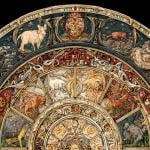in recent news an image of Jesus from the 4th century was found in Spain on a glass plate. This made the headlines not just for it’s age but because Jesus is pictured in Roman style with no beard and in a toga. http://www.bbc.co.uk/news/blogs-news-from-elsewhere-29480874 there are actually similar images in mosaics in Britain in Roman villas converted into early churches. now i think we can be pretty certain that whatever Jesus looked like as a 1st century Palestinian Jew he did not look like a Roman philosopher. But as we have no pictures or descriptions of Jesus we have no better idea how he did look.we have however got used to seeing Jesus portrayed in a certain way, with beard, robe and sandals to the extent that we find it odd for Jesus to not have a beard. Yet what those early British and Spanish Roman Christians did is something many others have done as the Christian message has spread around the world. a great way to explore this is in a resource called the Christ We Share which shows images of Jesus from around the world, all expressing Jesus in local context, some quite surprising to a westerner http://www.methodistpublishing.org.uk/books/ga202-ed-07/the-christ-we-share-3rd-edition what all these images remind us is that whilst it is important in understanding Jesus to place him in his 1st Century Jewish context, it is also true that in Jesus God is becoming one of us. It is not surprising therefore if as people have met God coming to them in Jesus in different times and cultures they have imagined Jesus as one of them.

Culture however, is not the only thing that makes people different. a sculpture of Jesus as a homeless man sleeping on a bench has been causing controversy on both sides of the pond. it seems that for some this identification upsets their views on street sleepers. However, a London church that does a lot to support the homeless also would not offer the sculpture a home, but on very different grounds. It felt the statue provided a stereotype of a homeless person they might not welcome, as well as being situated in an are in which the law forbade the actual homeless from sleeping on benches themselves. I wonder how a homeless person might depict Jesus as ‘one of them’? I also wonder what the impact was of the exporting of a blond European Jesus to the British colonies during the Victorian period? This Jesus was certainly not ‘one of them’. I suspect it never occurred to any European to question it, they were so use to thinking of Jesus as if he was European.

One of the most controversial images in the Christ We Share is called the Christa. It shows Jesus as a woman crucified. Here Jesus not only experiences human suffering but specifically the suffering of women. In a world in which women are disproportionally the victims of violence, abuse and oppression this is a powerful image. It also shocks because even if we don’t know what Jesus looked like we do know he was a man. But in spite of that the theology is right here too; Jesus comes to us as a woman also. If this image seems to be a modern feminist one, we need to think again. St Anselm a medieval Archbishop of Canterbury wrote a prayer to Jesus as mother feeding us at her breast. This image was also used by the female mystic Julian of Norwich. Jesus also refers to ‘himself’ as a mother hen nurturing her chicks.
The image of Jesus as a woman brings home the reality of Jesus as ‘one of us’ for women and allows them to see God not as other but as similar. This matters as much as Africans not having an image of a blond Jesus. I think the image of a female Jesus is important for men too. It not only helps men realize they are not somehow more like God but also to see the divine in women just as they need to see it in other men and people of other races and cultures. The God who is always like us is a God who is too likely to share our cultural, class and gender biases. A God that will not challenge us to find Jesus in the others who are not like us. a God safely in our comfort zone.
These images matter because they convey powerful messages to us about who is and is not included by God in Jesus. But it is not just our images that do this, so does our language. What are we doing to men and women the world over when God is only ever ‘He’ or ‘Lord’ or ‘Father’ and never ‘She’ or ‘Lady’ or ‘Mother’? This is not an issue of political correctness, but one of theological correctness; a male God is only every going to be half the story. We not only need other images of God we also need to re-imagine our language for God.










